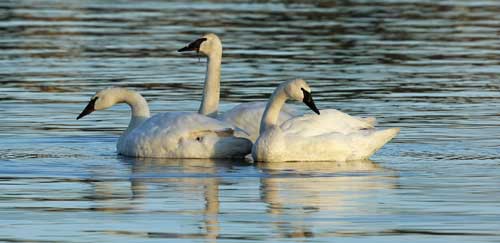In December 2008, the Arctic pummeled western Washington with a fist of ice and snow that paralyzed us for days. We weren’t the only ones to suffer. The swans who had settled in the Skagit for the winter were forced away from the farmers’ fields, where they liked to forage for fallen kernels of grain throughout the winter. Instead, they had to find new habitat in order to survive.
Several of them came here, to the Fill, where they found a welcome refuge. The decaying lilies and other water plants in the shallows of Union Bay provided a rich smorgasbord that the birds liked just as much as the grain they usually ate.
A dozen stayed until spring, providing a daily vision of grace and beauty that brought joy to all of us who gazed upon them. Among the swans who stayed were three babies. Well, teenagers, really. They were juvenile swans who had hatched in the Far North, grown their flight feathers there, and then migrated with their families. You could easily tell them apart from the grown-ups because Trumpeter Swan juveniles are gray. They don’t turn white until it’s time for them to head back north again in the spring.
For months the babies paddled around in the lake, gaining strength. As time passed, they began to separate from their parents, as teenagers do. They would paddle over to the Cut to forage, or drift among the marsh islands in the west. But no matter where they went, they stayed together. Almost always, they were within touching distance of each other, and often they would touch. A close family.
When spring came, they flew off to the north, together as always. I was both happy and sad to see them go. Babies must grow up and leave home. It is nature’s way, so I must feel happy that they grew strong enough to strike out on their own. Still, I worried for them, as I do for my own kids, grown up as they might be. Life is chancy, and there are many dangers.
Last December, though, the three swans returned, still together, still touching. They were all white now, fully adult. A proud sight to see them floating so gracefully in the bay. Another winter passed, and the swans flew again to the north when spring told them it was time to go.
I’ve been watching for them to come back again, ever since I turned the last page of my calendar to December. Would the swans return? Had they survived? Were they safe? Would I ever see them again? On the very last day of December, two appeared magically in Union Bay. “They’re back! They’re back!” I wrote ecstatically at the kiosk. Little did I know.
For on January 1, the first day of the New Year, I was out counting all the birds of the Fill for Seattle Audubon’s annual Christmas Bird Count. My husband and I set up my scope on the deck of the crew house to count the bazillions of ducks out on the bay. As I swiveled the scope back and forth, I looked for the two swans, hoping to add them to the count. Sure enough, there they were, swimming on the far side of the bay. As I watched them through the scope, a flurry of white appeared, a mighty splashing, water everywhere. I blinked, and there were SIX swans. Three touched each other briefly, then separated into pairs, never far from each other.
The kids have come home for the holidays, bringing their new mates with them. I am smiling so hard my cheeks hurt. Oh the joy.

